|
|
|
|||
|
|
||||
|
|
||||
| The (Jet)X Files | ||||
|
|
HOME | SITE MAP | FORUM | CONTACT |
|
||
|
ABOUT | MOTORS | MODELS | ARCHIVE | HISTORY | STORE | FAQ | LINKS
|
|
|
|
|
|
|||||||||||||||||||||||||||||||||||||||||||||||||||||||||||||||||||||
|
The (Jet)X Files 15 for
March 2004
by Roger Simmonds Reprinted from SAM 35 Speaks, March 2004 Afterburning Soon after writing last month’s discussion of camcorders, I received a copy of Mike Stuart’s latest CD video. Mike has put this together from the many recordings he and others have made at a number of 2003 meetings, for example the ‘Millenium Dome’, (I’m glad they’ve found a use for it at last), Old Warden, (including the very hot SAM 35 Gala), and Peterborough Flying Aces. Contact Mike if you would like a copy; the cost is a very reasonable |
|
|||||||||||||||||||||||||||||||||||||||||||||||||||||||||||||||||||||
|
It was good to reprise the glory of Mike’s Though I love the |
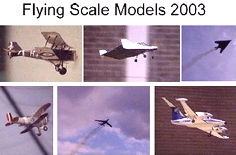  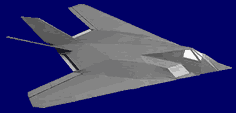
- photo by Graham Potter
|
|||||||||||||||||||||||||||||||||||||||||||||||||||||||||||||||||||||
|
Feedback I received a very nice letter from John Scott-Scott, who is happily both a SAM member and active in model engineering. John says, "you might like to know that at least one of your ‘historic references’ is still going". Indeed I did. John started rocketeering early: "I had some flights with the ‘Astral Rocket Plane’ [right], so bad that I fitted pendulum ailerons to stabilise it when it tried to Dutch roll". He adds, "it’s these ‘tricky’ subjects (I think he means all ‘Jetex’ type models) that bring out the best in we modellers". John has obviously not seen some of our video recordings or heard the language we can use. ‘Dutch rolling’, and, incidentally, tip stalling, are common problems with swept wing scale designs. A couple of degrees of wingtip washout is an well known and effective cure for the former, but it has taken the average modeller some time to realise that (perhaps counter intuitively) reducing dihedral and hence side area can help with the latter. Howard Metcalfe’s KeilKraft Hunter and Pete Smart’s Douglas Skyrocket (a Richard Crossley design) [right] both fly very nicely with anhedral. Pete’s aforementioned Sabre has less dihedral than the old KK kit, and from my observations of recordings of my own KK MiG 15, even this superlative design could benefit from rather less dihedral than the plan indicates. |

- Aeromodeller, Nov. 1946 (modified)

- Roger Simmonds
|
|||||||||||||||||||||||||||||||||||||||||||||||||||||||||||||||||||||
|
Early Wilmot Mansour models The first Jetex powered models revealed to the modelling ‘Great and Good’ included a tethered car and hydroplane [right]. Details of the latter, (which was 350 powered and inevitably called the ‘Hydrojet’), were published in The Model Boat Book (1950) by M.C. Cowell. This being so, I have some hopes that plans exist, somewhere, for the RTP aeroplane in a similar period publication. The search continues. |

- The Model Boat Book, 1950
|
|||||||||||||||||||||||||||||||||||||||||||||||||||||||||||||||||||||
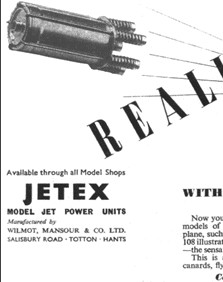
Does any reader know anything about this model? It was, I believe, part of the Jetex Exhibition at Southampton Aviation Museum, and looks so much nicer than the other early scale Jetex efforts that I’m surprised it was never marketed. Jetex were obviously proud of this model, which shows that Joe Mansour was (unsurprisingly, given his experience with embossed paper models at FROG) thinking of realistic scale models from the beginning. Unfortunately, he (and modellers) had to wait several years for the development of suitable balsa moulding techniques and the augmenter tube, and until Bert Judge and Mike Ingram had joined him, before his vision could be realised with the innovative ‘tailored’ designs. |
|

- Aeromodeller, 1949
|
||||||||||||||||||||||||||||||||||||||||||||||||||||||||||||||||||||

First, my apologies for the pun, which I was not strong enough to resist. Chris Strachan sent me an advertisement (Model Aviation News, 1950) [right] that included not only the M.E.W. 601 ‘Jet’ engine, but also the M.E.W. 707 Rocket Engine. Chris asks, "Does anybody know anyone who ran the 601, “the most perfect self-contained jet engine on the market”, and survived?" Doug Reefman, who obviously did survive, confessed on the Jet-Ex-Press discussion group: "I bought two from Science and Mechanics for $3.95. My brother and I fired one up in the basement one day, on a string tethered from the ceiling. It was loud and it took off at a high rate of speed, spinning in a circle until the string broke, when it flew into a concrete wall"! The 707 is for “advanced modellers and experimenters”, which is at least some admission of the difficulties with this unit. Its thrust is given as Given these commercial products, it is no surprise that making pulse jets and even athodyds (ram jets) was quite a popular activity for technically minded modellers who finished the War with relevant engineering experience. These engines are exciting and not particularly complicated machines, though they can be quite temperamental. There are now, inevitably, several Internet sites featuring various types of reaction motor for home construction, but in the good old days designs were printed on paper in the Aeromodeller, and a ‘ram jet test-rig’ was published in the late forties. Does any reader have a reference for this article? Eric Marsden drew the sketch below right from memory. He writes: “Many of us at that time had not learned the difference between pulse jets and athodyds. The former will run whilst stationary, taking in their own air, whilst the latter require a high-speed airstream, well beyond the velocities of modellers, to function. The athodyd test rig produced a fair amount of noise – but at that time I knew nothing of pressure waves or wave fronts, though I had learned that the ‘Borda mouthpiece’ was helpful for getting a one-way flow, and none of our efforts produced any thrust. At the time we were obsessed with smallness and lightness, and we only learned that engines could be profitably be made much more solidly when flying C/L with engines of pre-war design. I teamed up with a friend who understood pressure waves and had the necessary mathematics, and we built a whole series of pulse combustors from about 1' bore and 15" long to 3" bore and 5' long. We also had to build a large silencer box to house them during runs – the neighbours got a bit huffy over the explosive barks of the larger units, which were as loud as a 3.7" ack-ack gun! |
|

- Model Aviation News, 1950
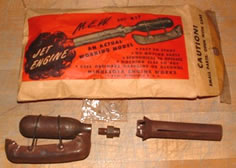  |
||||||||||||||||||||||||||||||||||||||||||||||||||||||||||||||||||||
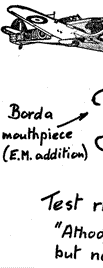
Eric adds, "it’s all in the past, and that’s another country." No manufacturer could now market the 606 or the 707, especially in the US, where it is, I’m afraid, difficult to import Rapiers and almost impossible purchase the bulk chemicals to fabricate their own motors. Benson Ball |
|
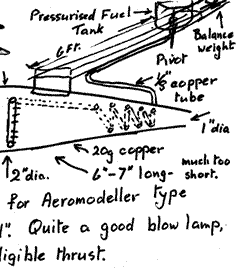
- Eric Marsden
|
||||||||||||||||||||||||||||||||||||||||||||||||||||||||||||||||||||
|
Though I really should know better, it is not unknown for my eyes to stray to the top shelf of the magazine racks at newsagents, or even to have a surreptitious look at the contents. I know there will be little of relevance to the Antique Modeller in any of these ‘glossies’; nor have I quite recovered from the shock of seeing pictures of ‘Vintage ARTF’ aeroplanes. However, there is a contemporary publication devoted to jets (the radio controlled turbojet powered variety) that I did peruse in the comfort of my own home with the doors locked. This generated some reflection: what are the vintage forebears of the sophisticated and (very) expensive examples of the manufacturers’ art illustrated therein? Surely not Colonel Taplin’s pulse-jet powered model? The engine (see photo) might be nine inches long and ‘pulsate at 400 beats per minute’, but the model appears to be a modified petrol engine powered free flight design and would have looked desperately old fashioned even at the time. Perhaps it was just a test bed; I have doubts it ever flew, for, as the good Colonel said, "the photograph was rigged as far as the flight appearance is concerned". There were more sophisticated models around (see ‘The Dynajet flying wing that rocked Eaton Bray’, SAM Yearbook No 11), but for a true progenitor of today’s beautifully engineered models one must look elsewhere, perhaps to the legendary W. Benson-Ball. W. Ball published an intriguing article, ‘Flight Testing and Development of Model Jet units and Aircraft,’ in the 1954 Aeromodeller Annual. W. Benson-Ball followed with three articles, ‘Experiments with Model Jets and Deltas’, (Model Aircraft, 1960, Oct. onwards). |
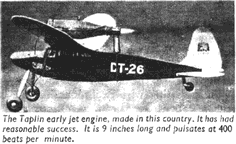
- C.E. Bowden, Model Jet Reaction Engines, 1948
(reprinted TEE Publishing, Nov. 1953) |
|||||||||||||||||||||||||||||||||||||||||||||||||||||||||||||||||||||
|
Mr Ball’s first flying wing, made of ‘solid balsa’ and powered by a Brocks’ 6d ‘Fire trail,’ flew in the summer of 1942. Not surprisingly, it “caused quite a commotion and [the] instant intervention of the law”. After that, things moved apace. V E Day saw him successfully fire up his first model turbojet; by the end of 1947 he had flown deltas powered by solid fuel rockets that developed a thrust of eight ounces. Only a little later his radio controlled His publications, especially the later ones, are erudite, though the style is a little patronising, indeed, haut en bas, but then who can blame him? His models, he says, "are of course far from a beginner’s project … my constructional methods are a little out of the rut … I have for quite a few years made use of fibre glass extensively … six months’ to a year’s work must go into them". His discussion of delta design is eminently sensible; "the lateral (Dutch roll) and spiral instability so often complained of in deltas is easily overcome … anhedral only must be used, either by tapering the wing thickness on the upper surface, or by incorporating up to 5° in the effective span". Overall, this is all very impressive stuff, enough to give any reader a distinct inferiority complex. 
- Aeromodeller Annual, 1954 (p.88)
I wondered what sort of impact these articles had at the time. Stan Pearson (who tracked down the Aeromodeller Annual references for me) says: "as to Mr Benson Ball and his Incredible Flying Machines, I think the first reactions were one of disbelief. Perhaps he was some fictitious "Boy’s Own" character designed to thrill a youthful audience". I asked John Scott-Scott for his opinion. John wrote back: "I read of this at the time, but, like many others, I found the reported data rather ‘way out’. It seemed too much for a model project .… he may have been some sort of test pilot with access to MOD information. The text reads like a professional aeronautical engineer’s report … so the rockets plus pulse jets I can believe, but not the turbojets, as they have taken time to develop even for Ministry UAV projects." ‘Commander Benson’ is last spotted in the 1974 Aeromodeller Annual, holding a very high powered shrouded fan delta. The photo caption reads, "Cdr Benson at Mojave Desert test site for his R/C XD 110A which has recorded flight speeds up to 262 mph". Does any reader know anything more about him? I wonder what became of ‘Commander Benson’, and I would love to know more about this most extraordinary man and his achievements. Now here’s a thought to ponder: a radio controlled Though I admire the engineering skill modern R/C jets display, it is not at all the kind of thing I myself want to do. But that does not mean the designs of Benson Ball have no attraction for me. If we can allow miniatures of vintage gas buggies powered by small diesels and CO2 engines, we could certainly make a scaled down |
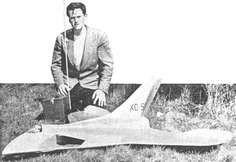
- Aeromodeller Annual, 1954 (p.87)
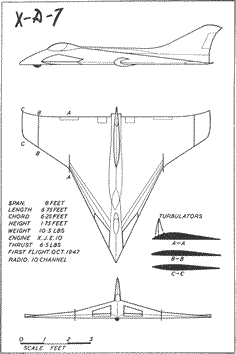
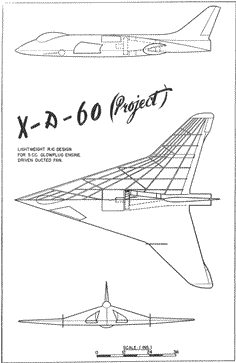
- Aeromodeller Annual, 1954 (p.87)
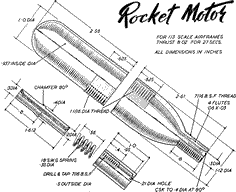
- Aeromodeller Annual, 1954 (pp.90-91)
|
|||||||||||||||||||||||||||||||||||||||||||||||||||||||||||||||||||||
|
|
||||||||||||||||||||||||||||||||||||||||||||||||||||||||||||||||||||||
|
|
|
|||||||||||||||||||||||||||||||||||||||||||||||||||||||||||||||||||||
|
|
|
|
|
|
|
|
Acknowledgements - Article: Roger Simmonds - Illustrations: Eric Marsden (Athodyd test rig) MAAC archives via Bill Henderson (pictures of Ball and his models and drawings) Richard Crossley (Skyrocket) Roger Simmonds (other illustrations) |
|
|
|
|
ABOUT | MOTORS | MODELS | ARCHIVE | HISTORY | STORE | FAQ | LINKS |
|
|
Terms of Use
|
Queries? Corrections? Additions?
Please
contact us.
|
|